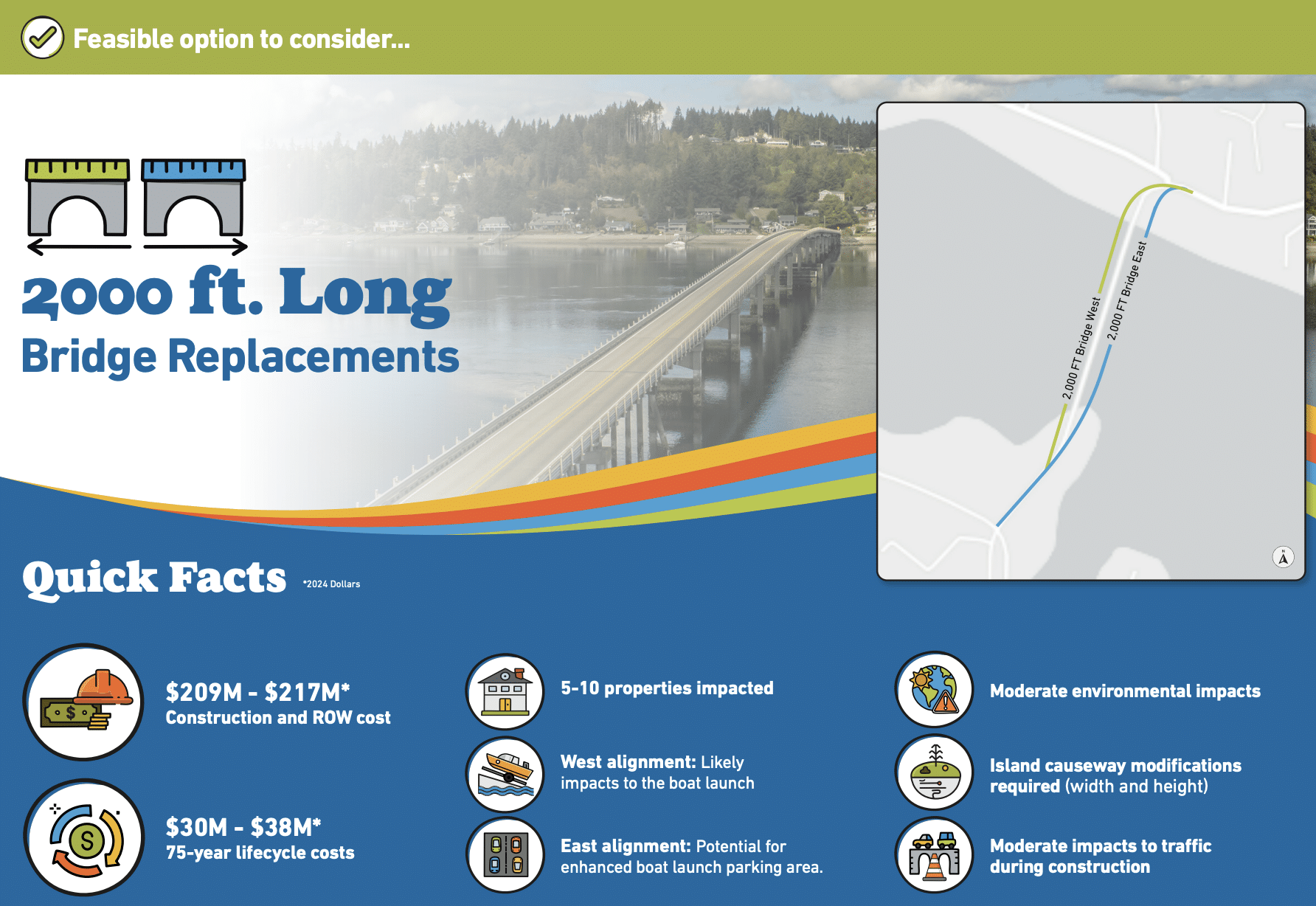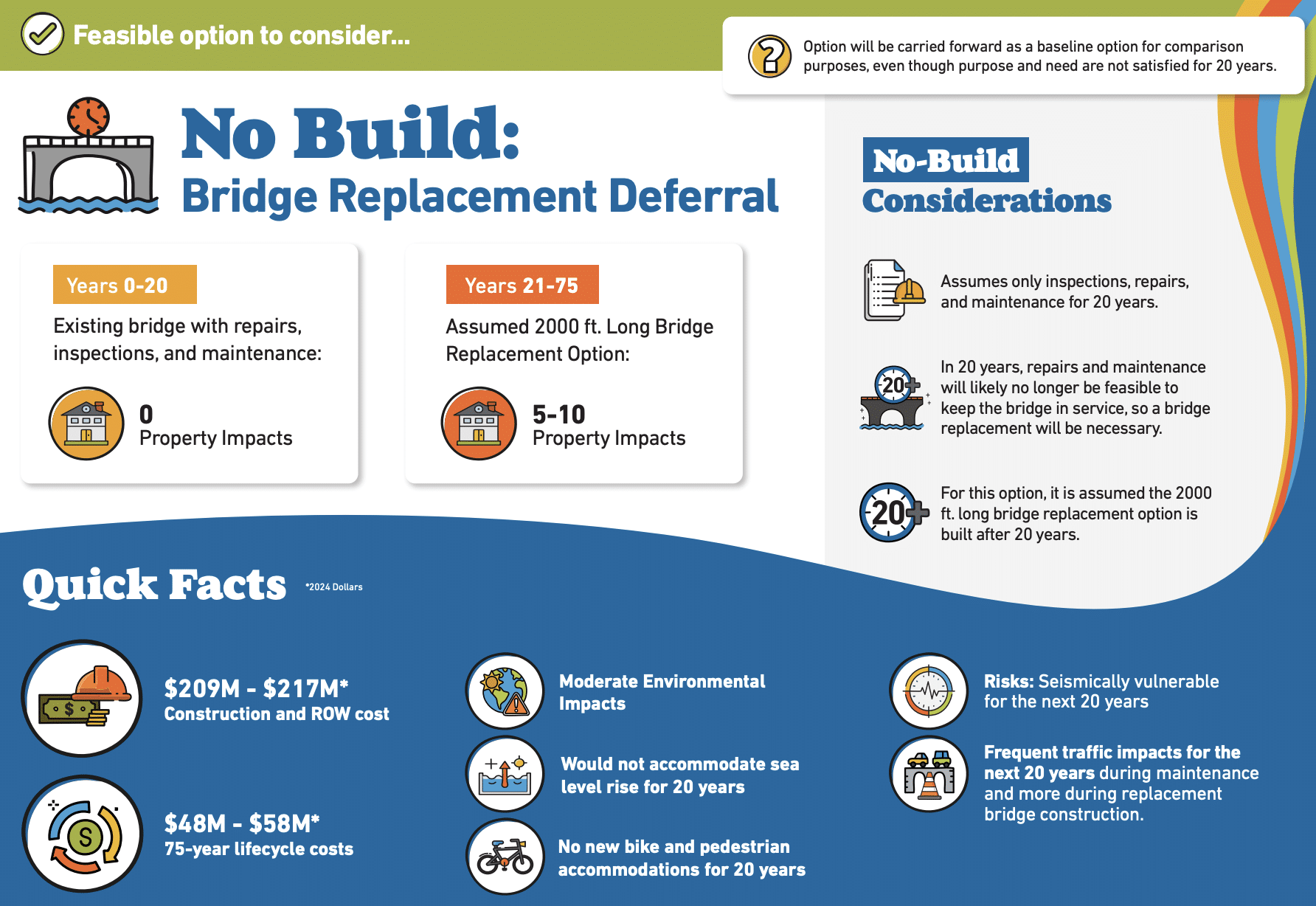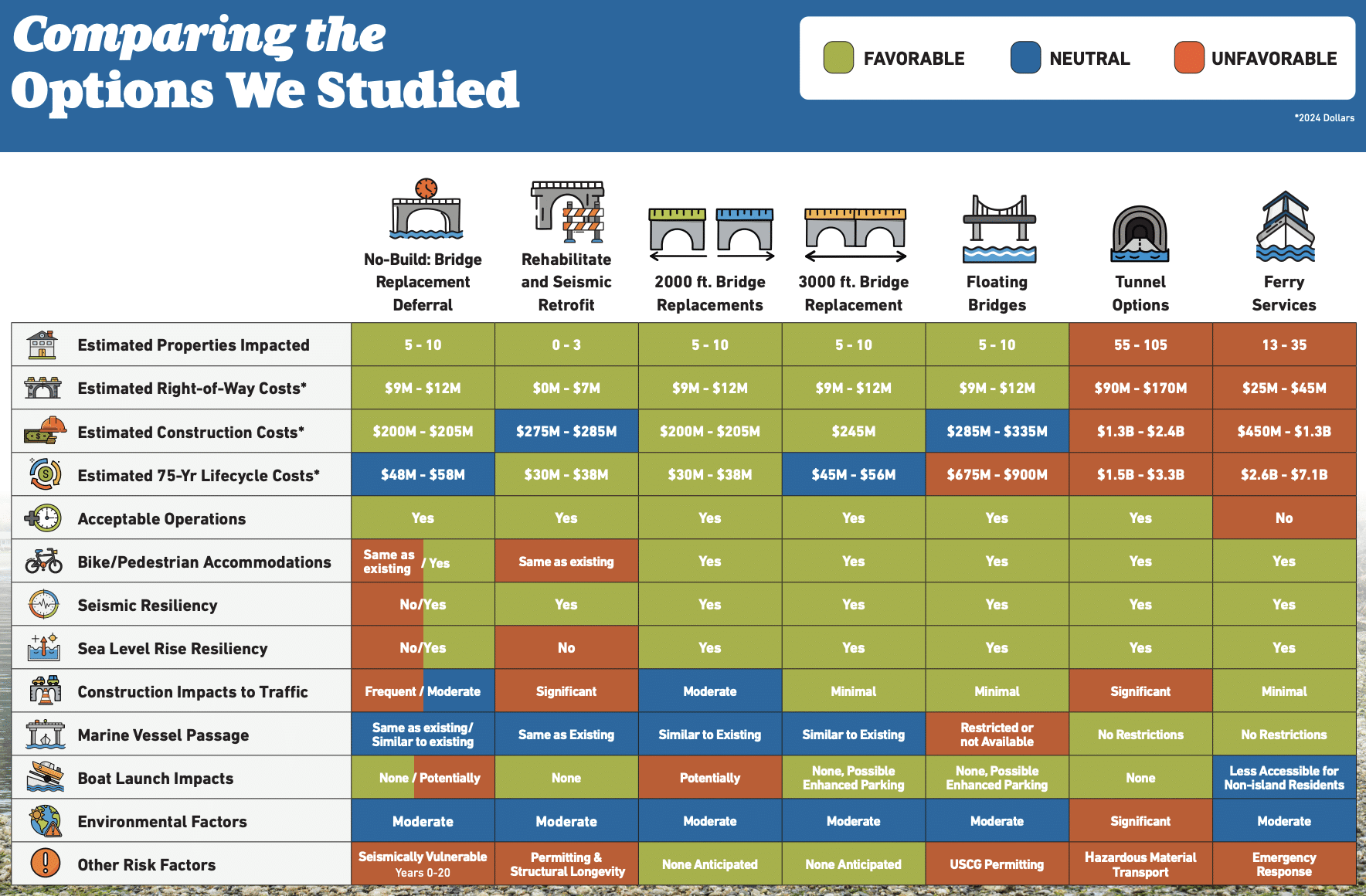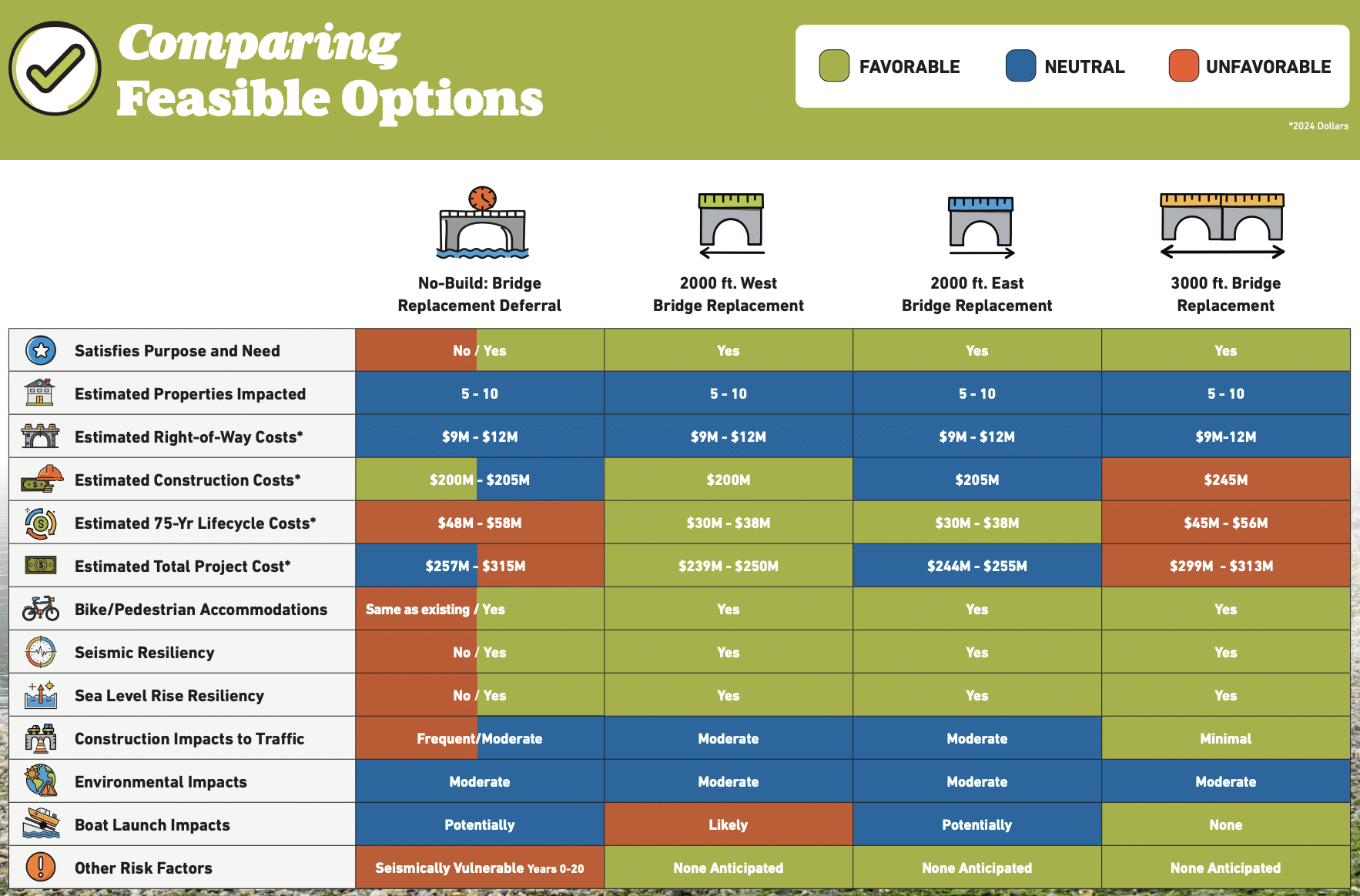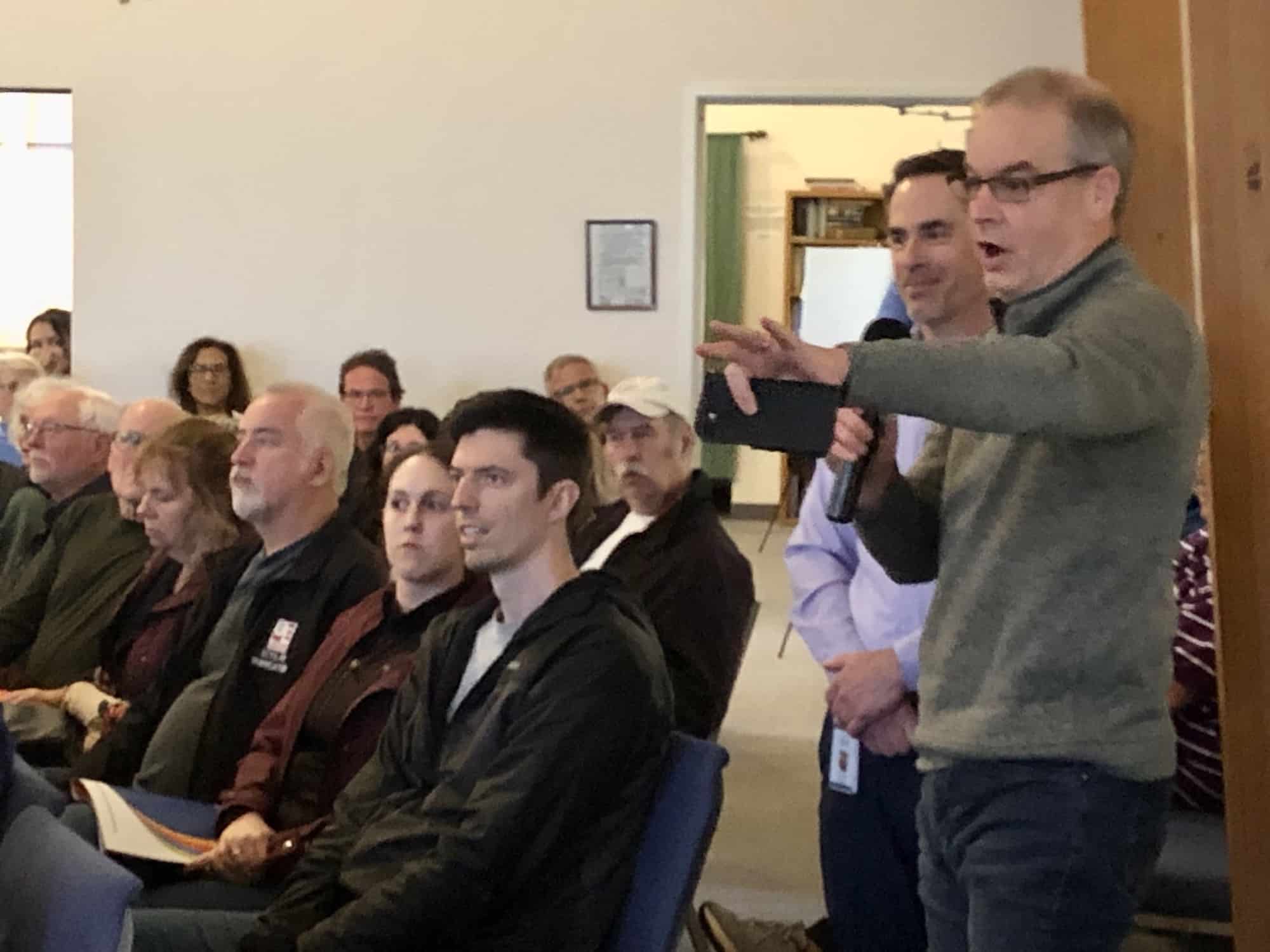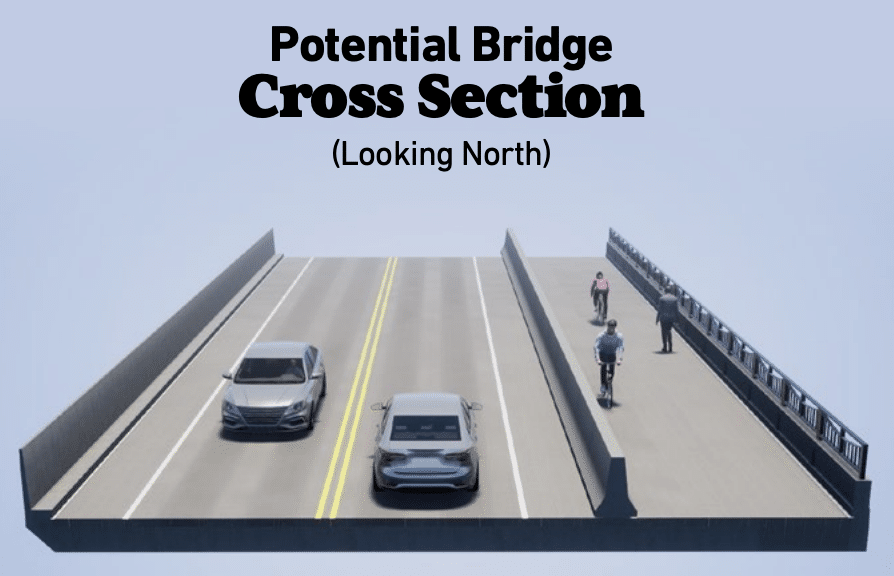Community Government Transportation
Four options emerge for Fox Island bridge replacement
A new Fox Island crossing’s type, size and location would likely look much like the existing bridge, according to an aptly titled study.
Four options advanced by consultant HDR and Pierce County Planning and Public Works comprise typical bridge structures crossing near the 1954 span. Less conventional floating bridges, tunnels and ferries were rejected as unfeasible, they told about 250 people who attended an open house Tuesday night at Fox Island United Church.
Alternatives continuing in the study include a 2,000-foot bridge just east of the current 1,950-footer, a 2,000-foot bridge alongside the west of it and a 3,000-foot bridge that arches out farther to the west, said HDR design lead Brian Bombardier.

HDR design lead Brian Bombardier answers questions from Fox Island residents huddled around a display board. Photo by Ed Friedrich
They would all require impacting five to 10 properties at a cost of $9-12 million, feature a roundabout at the Warren Drive end, endure at least 75 years and be 42 feet wide with two 11-foot car lanes, 4-foot shoulders and a separated 12-foot pedestrian/bicycle path.
2,000-foot bridges estimated at about $215 million
The 2,000-footers would replicate the current bridge and cost an estimated $209 to $217 million in today’s dollars. They would use the existing causeway on the island side, though it would need to be raised for a forecasted 3-foot sea level rise and widened for pedestrians. The west option would conflict with the boat launch, which is owned by the federal Bureau of Land Management and holds special priority under environmental law. The east one wouldn’t.
The 3,000-footer, costing an estimated $254-257 million, would not use the causeway and alight on property west of the boat launch, freeing the causeway for boat launch access and parking.
The fourth option assumes building one of the 2,000-footers after milking the existing bridge with only inspections, repairs and maintenance for the next 20 years. It would not accommodate sea rise, would be seismically vulnerable and offer no new bike and pedestrian access.
Repair and replacement costs
“This bridge can only be repaired so many times,” Bombardier said. “The county has determined we may get 20 years out of it if we put all kinds of Band-Aids on, but in 20 years we’ll have to replace it. It will cost as much as a replacement plus 20 years of maintenance and repair.”
Among the rejected options was to rehabilitate and retrofit the existing bridge over time while in use. That would include concrete repairs and patches throughout, strengthening the existing girders, a full deck overlay and new bridge supports built around existing supports. It would be expensive ($275 to $292 million), not accommodate sea rise or structural longevity, add no pedestrian accommodations and cause significant traffic impacts for years. And it’d still be a fairly old bridge, but one that could survive an earthquake.
“I don’t think it’d be environmentally permitted because of the piecemeal construction,” Bombardier said.
Floaters, tunnels ruled out
The $1.8 million study analyzed two types of floating bridges. At an estimated $294 to $374 million to build and $675-900 million to operate and maintain for 75 years, they would be costly.
“We would lose naval vessel clearances under the bridge,” Bombardier said. “That would be the fatal flaw as the Coast Guard likely wouldn’t permit it.”
The study vetoed tunnels because of environmental impacts, number of property acquisitions (55-105), bike and pedestrian challenges, and extreme construction ($1.4 to $2.6 billion) and lifecycle ($1.5 to $3.3 billion) costs. Gig Harbor resident Randy Boss, citing his own research, claims it could be done for $50 million.
Three ferry routes were examined, from Point Fosdick, Point Defiance and Steilacoom. The option was dropped because of the number of property acquisitions (13-35), extreme construction ($475 million to $1.3 billion) and lifecycle ($2.6 to $7.1 billion) costs, and unacceptable travel time.
“The biggest deal killer here was travel time — 30 to 100 minutes,” said Bombardier.
What’s it going to cost us personally?
After Bombardier and Pierce County Field Engineering Manager Kraig Shaner completed the presentation, they took questions.
Participants focused mostly on money and not on the options presented. They asked why they didn’t get to vote on building a bridge, why is the county is spending millions of dollars on a White River bridge and other priorities instead of Fox Island, why do residents need to contribute more than their usual property taxes, what about buying a bridge from the Army Corps of Engineers, why doesn’t everybody call the White House?
Island resident Emanuel Schroeter said choosing a bridge option is like walking into a car dealership and being asked which car you want without knowing the price.
“What’s it going to cost me? That’s the determining factor on everybody’s mind,” he said. “Property tax? Toll? Whatever?
“I know that’s what everybody here is wondering,” Shaner replied. “How are you going to pay for it? The county’s goal is to get as much outside money (federal and state) as we can. We’re trying to work all these together and figure out a course moving forward.”
County Councilwoman Robyn Denson, who represents Fox Island, said she’s doing everything she can to find federal and state support.
“My goal is to start putting some money away in anticipation,” she said. “The county’s going to have a big role in this. It’s our road. We’ve got to figure it out. I’ve been talking for years with our federal and state delegations about this project, saying at some point I’ll be coming to you with an ask. They should be prepared.”
County ultimately responsible
Shaun Darby wanted to know how much money the county has allocated for the bridge this biennium and next.
“Frankly, the answer is zero,” said County Engineer Letticia Neal, noting that funds aren’t normally earmarked so far in advance before there’s a design or exact cost. “This is a county bridge and we’ve got to find a way. There are just no other options. We need the bridge.”
“It’s the county’s bridge, it’s a county problem,” Darby said. “It came out of the engineer’s mouth.”
A Fox Island resident who wouldn’t give her name spoke for many in the crowd.
“I think the overwhelming decision is how much it’s going to cost and how much it’s going to cost me and how much impact it’ll have on the rest of my life,” she said. “Do I need to move? I think the county is doing a decent job getting information out, but at the end of the day the outstanding issue is how much is it going to cost me? Will there be a mass exodus from the island? Will it affect our ability to sell? It goes on and on.”
Timeline
The county expects the report to be completed by the end of the year. In 2026, it will begin the environmental screening process on the four feasible options and hold another open house to gather community feedback it. The environmental screening, along with the TS&L and the community’s feedback, will help inform the final preferred alternative, Said county spokeswoman Danielle Winski. The project will move into advanced design, environmental permitting and funding in 2026-27. Property will be appraised and acquired in 2028-29, followed by construction in 2030-2031.
A preliminary type, size and location study completed in 2016 determined replacement of the bridge is the best solution. A rehabilitation or retrofit would not be cost-effective.
A routine inspection in 2023 gave the bridge, which carries about 6,500 vehicles per day, a “poor” rating. It doesn’t meet current design standards seismically, structurally or functionally. It was built using standards from more than 70 years ago. It has narrow lanes, no shoulders, no bike paths and its sidewalks are not compliant with the American with Disabilities Act. A retrofit is not feasible to bring it up to current standards and condition, according to the county.
Another meeting in June
Denson was happy to see the large number of residents who came Tuesday to learn about the options and voice their opinions, suggestions and questions. She encourages them to attend a full county council meeting June 2 at Nichols Center to hear results of the open house and meet those who’ll be making funding decisions about the bridge.
An online open house is available until April 29.

